The Basilica of Santa Maria Maggiore is the largest church in Rome dedicated to the ‘Virgin Mary’. The church, which dates back to the fifth century, has a magnificent interior with a quite spectacular gilded ceiling and ornate chapels.

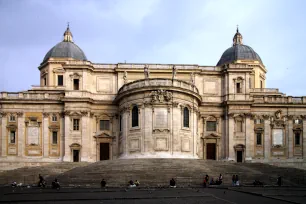
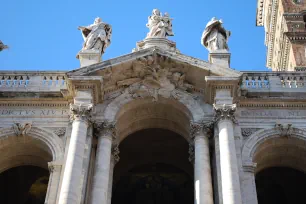
Santa Maria Maggiore (St. Mary Major) is one of four papal basilicas in Rome (the others are the St. Peter’s Basilica, the St. John’s Basilica and the St. Paul’s Basilica). The church is located on the Cispius, a summit of the Esquiline Hill.
The name of the church (“major”) implies that it is the most important of the eighty churches in Rome that are dedicated to Mary.
Legend of the Snow
The church is sometimes called the Santa Maria della Neve (St. Mary of the Snow) or Liberian Basilica, a reference to the medieval Legend of the Snow.
According to the legend, the patrician John, landowner of the Esquiline Hill, had a dream on the night of August 4 in the year 352. In the dream, the Virgin Mary appeared and told him to build a church at the site where snow would fall the next day. That same night, Pope Liberius had the same dream.
When the following day – in the middle of a scorching summer – word spread that snow had fallen on the Esquiline Hill, the patrician and the pope hastily ran towards the site of the miracle, where they saw that the fresh snow had fallen in the shape of a floor plan for a church. Liberius then decided to build a basilica at this site in honor of Mary.
There are, however, no ancient documents that support the story of the snow in August. In fact, it is so unbelievable that in the eighteenth century, even Pope Benedict XIV wanted to remove it from the breviary.
Construction
In reality, the church built by Liberius was originally not dedicated to Mary, and it might even have been built elsewhere. The current church dates from the time of Pope Sixtus III, who reigned from 432 to 440. It was built shortly after the First Council of Ephesus (431), where the dogma of Mary’s divine motherhood was proclaimed. The church was built in the tradition of a large Roman basilica, without a transept.
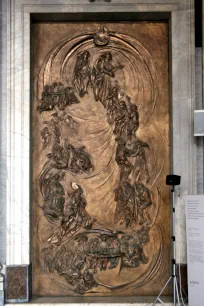

In the fourteenth century, a bell tower was added to help guide pilgrims to their destination. Later, in the late sixteenth and early seventeenth centuries, two large chapels were added, which changed the layout into one resembling a Latin Cross.
Exterior
Over the centuries, the church has undergone many changes. The facade, with its two-story arcade, was added in 1743. It was commissioned by Pope Benedict XIV and built to designs by Ferdinando Fuga. It covers an older twelfth-century facade decorated with mosaics added in the late thirteenth century by Filippo Rusuti.
The mosaics are still visible and tell the story of the miraculous snowfall in August. To the left is the Porta Sancta (Holy Door), which is only opened during a jubilee year (once every twenty-five years). To the right is a statue of Philip IV of Spain, who granted a perpetual yearly donation to the church. The statue was designed by Bernini and created in 1692 by Girolamo Lucenti.
The seventy-five-meter bell tower – the tallest in Rome – was built in 1377, shortly after the popes returned from their exile in Avignon. The pyramidal spire was added much later, in the early sixteenth century.
Interior

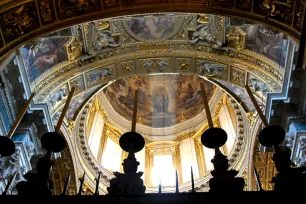
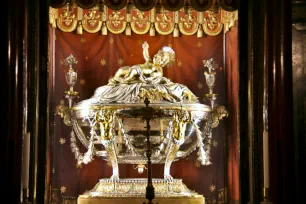
The basilica of Saint Mary Major is best known for its magnificent interior, which still resembles that of an ancient basilica. It has a length of almost eighty-six meters and is divided into three naves by thirty-six Ionic columns of marble and granite.
Above the columns, right below the windows, is a row of mosaics from the early fifth century. The mosaics depict thirty-six scenes from the Old Testament.
Another highlight in the basilica is the beautiful coffered ceiling designed by Giuliano da Sangallo and created in the sixteenth century. It is said to be gilded of gold that was brought from the Americas by Christopher Columbus and presented to Pope Alexander VI by the Spanish king.
The papal altar at the apse is covered by an ornate baldachin. The baldachin is supported by four ancient columns that were taken from the Villa of Hadrian in Tivoli. The area under the baldachin is known as the Crypt of the Nativity. Here you can see an ornate silver and gold reliquary designed by Giuseppe Valadier. It is known as the Reliquary of the Holy Crib and is said to contain wood from the Holy Crib of the nativity of Jesus.
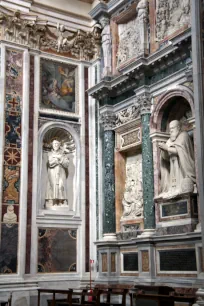
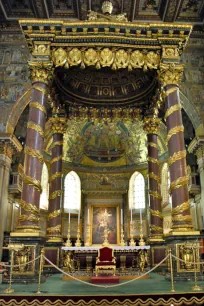
The apse is decorated with a magnificent mosaic created in 1295 by Jacopo Torriti. It depicts the ‘Crowning of Mary’ with Christ and Mary seated on a throne and accompanied by saints. Pope Nicholas IV, who commissioned the work, is shown kneeling alongside cardinal Giacomo Colonna.
Two large chapels opposite one another, The Capella Borghese and Capella Sistina, form the church’s transept. The chapel on the right is the Capella Sistina or Sistine Chapel, named for Pope Sixtus V who commissioned its construction. The chapel, designed by Domenico Fontana and built in 1587, holds precious relics and contains the tombs of Popes Pius V (†1572) and Sixtus V (†1590).
The Capella Borghese, also known as the Capella Paolina, was built later, in 1611, by Flaminio Ponzio. The chapel is named after Pope Paul V Borghese. According to legend the Madonna in the Borghese chapel, the ‘Salus Populi Romani’, was painted by the evangelist Lucas and completed by angels. More likely, it was created in the Middle Ages, probably around the thirteenth century. The Popes Paul V (†1621) and Clement VIII (†1605) are buried in this chapel.
The most famous figure buried in the church of Saint Mary Major is Gian Lorenzo Bernini (†1680), one of the greatest artists in history. Very much aware of his own greatness, Bernini designed a monumental tomb for himself during the last decade of his life. Disappointingly, the tomb was never built, and a simple gravestone now marks the grave of Bernini and his family members.
Piazza Santa Maria Maggiore
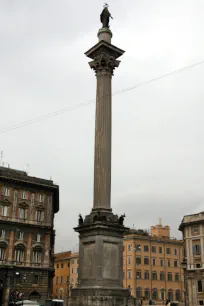
In the middle of the Piazza Santa Maria Maggiore, the square in front of the church, stands a column with a Baroque bronze statue of Mary and child. It is known as the Colonna della Pace (Column of Peace) and was erected in 1614 by Pope Paul V in thanks for the remission of the plague. The 14-meter-tall column was taken from the Basilica of Maxentius at the Roman Forum. The statue was created by the French sculptor Guillaume Berthélot.
The obelisk located at the other side of the church, on the Piazza dell’Esquilino, is known as the Obelisco Esquilino (Esquiline Obelisk). It was erected in 1587 by Pope Sixtus V as a beacon for pilgrims. It was originally located near the entrance of the Mausoleum of Augustus. A wide staircase behind the obelisk leads to the apse of the church. From here you have a splendid view over the square and its surroundings.

